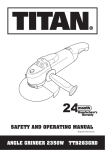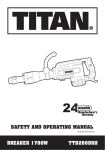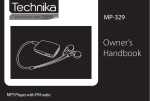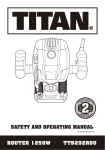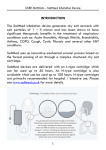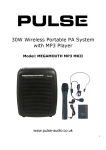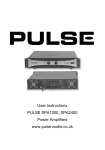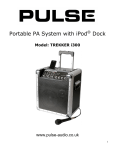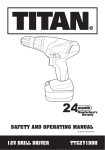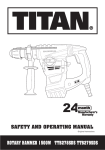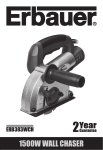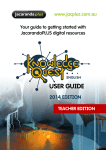Download planer 900w ttb291pln - Free-Instruction
Transcript
24 SAFETY AND OPERATING MANUAL Original instructions PLANER 900W TTB291PLN Congratulations on your purchase of a power tool from Titan Power Tools (UK) Ltd. We want you to continue getting the best performance from it so this handbook includes information on safety, handling and care. Please retain this handbook in case you need to refer to any of the information in the future. Your power tool comes with a 24-month guarantee, so should it develop a fault within this period contact your retailer. GUARANTEE This product carries a guarantee of 24 months. If your product develops a fault within this period, you should, in the first instance contact the retailer where the item was purchased. This guarantee specifically excludes losses caused due to: - Fair wear and tear - Misuse or abuse - Lack of routine maintenance - Failure of consumable items (such as batteries) - Accidental dammage - Cosmetic damage - Failure to follow manufacturer’s guidelines - Loss of use of the goods This guarantee does not affect your statutory rights. This guarantee is only valid in the UK. For any enquiries relating to the guarantee please refer to your retailer. GENERAL SAFETY INSTRUCTIONS WARNING! Read all safety warnings designated by the symbol all instructions. and WARNING! Read all safety warnings and all instructions. Failure to follow the warnings and instructions may result in electric shock, fire and/or serious injury. Save all warnings and instructions for future reference. The term "power tool" in the warnings refers to your mains-operated (corded) power tool or battery-operated (cordless) power tool. 1. Work area safety a. Keep work area clean and well lit. Cluttered or dark areas invite accidents. b. Do not operate power tools in explosive atmospheres, such as in the presence of flammable liquids, gases or dust. Power tools create sparks which may ignite the dust or fumes. c. Keep children and bystanders away while operating a power tool. Distractions can cause you to lose control. 2. Electrical safety a. Power tool plugs must match the outlet. Never modify the plug in any way. Do not use any adapter plugs with earthed (grounded) power tools. Unmodified plugs and matching outlets will reduce risk of electric shock. b. Avoid body contact with earthed or grounded surfaces, such as pipes, radiators, ranges and refrigerators. There is an increased risk of electric shock if your body is earthed or grounded. c. Do not expose power tools to rain or wet conditions. Water entering a power tool will increase the risk of electric shock. d. Do not abuse the cord. Never use the cord for carrying, pulling or unplugging the power tool. Keep cord away from heat, oil, sharp edges or moving parts. Damaged or entangled cords increase the risk of electric shock. e. When operating a power tool outdoors, use an extension cord suitable for outdoor use. Use of a cord suitable for outdoor use reduces the risk of electric shock. f. If operating a power tool in a damp location is unavoidable, use a residual current device (RCD) protected supply. Use of an RCD reduces the risk of electric shock. 3. Personal safety a. Stay alert, watch what you are doing and use common sense when operating a power tool. Do not use a power tool while you are tired or under the influence of drugs, alcohol or medication. A moment of inattention while operating power tools may result in serious personal injury. b. Use personal protective equipment. Always wear eye protection. Protective equipment such as dust mask, non-skid safety shoes, hard hat, or hearing protection used for appropriate conditions will reduce personal injuries. c. Prevent unintentional starting. Ensure the switch is in the off-position before connecting to power source and/or battery pack, picking up or carrying the tool. Carrying power tools with your finger on the switch or energising power tools that have the switch on invites accidents. PLANER 900W TTB291PLN d. Remove any adjusting key or wrench before turning the power tool on. A wrench or a key left attached to a rotating part of the power tool may result in personal injury. e. Do not overreach. Keep proper footing and balance at all times. This enables better control of the power tool in unexpected situations. f. Dress properly. Do not wear loose clothing or jewellery. Keep your hair, clothing and gloves away from moving parts. Loose clothes, jewellery or long hair can be caught in moving parts. g. If devices are provided for the connection of dust extraction and collection facilities, ensure these are connected and properly used. Use of dust collection can reduce dust-related hazards. 4. Power tool use and care a. Do not force the power tool. Use the correct power tool for your application. The correct power tool will do the job better and safer at the rate for which it was designed. b. Do not use the power tool if the switch does not turn it on and off. Any power tool that cannot be controlled with the switch is dangerous and must be repaired. c. Disconnect the plug from the power source and/or the battery pack from the power tool before making any adjustments, changing accessories, or storing power tools. Such preventive safety measures reduce the risk of starting the power tool accidentally. d. Store idle power tools out of the reach of children and do not allow persons unfamiliar with the power tool or these instructions to operate the power tool. Power tools are dangerous in the hands of untrained users. e. Maintain power tools. Check for misalignment or binding of moving parts, breakage of parts and any other condition that may affect the power tool’s operation. If damaged, have the power tool repaired before use. Many accidents are caused by poorly maintained power tools. f. Keep cutting tools sharp and clean. Properly maintained cutting tools with sharp cutting edges are less likely to bind and are easier to control. g. Use the power tool, accessories and tool bits etc. in accordance with these instructions, taking into account the working conditions and the work to be performed. Use of the power tool for operations different from those intended could result in a hazardous situation. 5. Service a. Have your power tool serviced by a qualified repair person using only identical replacement parts. This will ensure that the safety of the power tool is maintained. ADDITIONAL SAFETY INSTRUCTIONS FOR YOUR PLANER 1. Wait for the cutter to stop before setting the tool down. An exposed cutter may engage the surface leading to possible loss of control and serious injury. 2. Always wear a dust mask and hearing protectors when using this planer. 3. Do not use damaged or worn blades. Use only sharp blades. 4. Periodically check the screws that hold the blades, loose blades can cause damage to materials and injuries. 5. Do not start the machine when the blade is in contact with the workpiece. 6. Always move the planer in the cutting direction. 7. Maintain constant pressure on the front and rear of planer. 8. Always inspect and remove all nails and screws etc from timber before planing. Always check with a metal detector. 9. Ensure the workpiece is firmly clamped to prevent movement. 10. Where possible, seal off the working area to contain the dust for later removal. 11. Always use the appropriate safety equipment that is required for the product. e.g. goggles/Safety Spectacles, Ear defenders(essential with tools with a noise rating of over 80dB(A), Gloves and face masks. In all ensure that the safety equipment is in good condition. WARNING! Some dust particles created by power sanding, sawing, grinding, drilling and other construction jobs contain chemicals known to cause cancer, birth defects or other reproductive harm. Some examples of these chemicals are: Lead from lead-based paints. Crystalline silica from bricks and cement and other masonry products. Arsenic and chromium from chemically treated timber. Your risk form these exposures varies, depending upon how often you do this type of work. To reduce your exposure to these chemicals: Work in a well ventilated area. Work with approved safety equipment, such as those dust masks that specially designed to filter out microscopic particles and use the dust extraction facility at all time. VIBRATION The European Physical Agents (Vibration) Directive has been brought in to help reduce hand arm vibration syndrome injuries to power tool users. The directive requires power tool manufacturers and suppliers to provide indicative vibration test results to enable users to make informed decisions as to the period of time a power tool can be used safely on a daily basis and the choice of tool. Further Advice can be found at www.hse.gov.uk Vibration total values (triax vector sum) determined according to EN 60745: Planing PLANER 900W Vibration planing ah = 2.671m/s2 Uncertainty K = 1.5m/s2 TTB291PLN The declared vibration emission value should be used as a minimum level and should be used with the current guidance on vibration. Calculating the actual period of the actual period off use can be difficult and the HSE website has further information. The declared vibration emission been measured in accordance with a standardised test stated above and may be used to compare one tool with another. The declared vibration emission value may also be used in a preliminary assessment of exposure. Warning: The vibration emission value during actual use of the power tool can differ from the declared value depending on the ways in which the tool is used dependant on the following examples and other variations on how the tool is used: How the tool is used and the materials being cut. The tool being in good condition and well maintained The use of the correct accessory for the tool and ensuring it is sharp and in good condition. The tightness of the grip on the handles. And the tool is being used as intended by its design and these instructions. This tool may cause hand-arm vibration syndrome if its use is not adequately managed Warning: identify safety measures to protect the operator that are based on an estimation of exposure in the actual conditions of use (taking account of all parts of the operating cycle such as the times when the tool is switched off and when it is running idle in addition to the trigger time).Note The use of other tools will reduce the users’ total working period on this tool. Helping to minimise your vibration exposure risk. Maintain this tool in accordance with these instructions and keep well lubricated (where appropriate) Avoid using tools in temperatures of 10°C or less Plan your work schedule to spread any high vibration tool use across a number of days. Health Surveillance All employees should be part of an employer’s health surveillance scheme to help identity any vibration related diseases at an early stage, prevent disease progression and help employees stay in work. Double insulation: The tool is double insulated. This means that all the external metal parts are electrically insulated from the mains power supply. This is done by placing insulation barriers between the electrical and mechanical components making it unnecessary for the tool to be earthed. Important note: Be sure the supply is the same as the voltage given on the rating plate. The tool is fitted with a two-core cable and plug. Remove the mains plug from socket before carrying out any adjustment or servicing. SYMBOLS To reduce the risk of injury, user must read instruction manual Warning Waste electrical products should not be disposed of with household waste. Please recycle where facilities exist. Check with your Local Authority or retailer for recycling advice. Wear ear protection Wear eye protection Wear dust mask Double insulation Conformity to CE directive PLANER 900W TTB291PLN 4 2 3 5 1 6 7 1 Cut depth adjustment knob 2 Dust collection bag 3 Lever right/left for extraction port 4 Lock-off button 5 ON/OFF trigger switch 6 Dust extraction port 7 Parallel guide TECHNICAL DATA Voltage: Input power: No load speed: 230-240V~ 50Hz 900W 16000/min Planing width: 82mm Cutting depth: 0-3mm Rebate depth: 0-12mm Protection class: II Machine weight: 3.3kg NOISE DATA A weighted sound pressure A weighted sound power Wear ear protection when sound pressure is over 90.2dB(A) / KpA: 3dB(A) 101.2dB(A) / KwA: 3dB(A) 80dB ACCESSORIES Dust collection bag Depth guide Parallel guide Spanner Hex key Drive belt PLANER 900W 1pc 1pc 1pc 1pc 1pc 1pc TTB291PLN OPERATIONS INSTRUCTIONS Note: Before using the tool, read the instruction book carefully. INTENDED USE This planer shall be used for wood working only. Other uses for the tool will lead to the damage of the tool and a series of dangers to the operator. This tool is intended for DIY home use, or occasional professional use. Fig. 1 1. SWITCHING ON AND OFF (Fig. 1) To start the tool, firstly press in the lock off button(4) fully, then depress the on/off switch(5). Release the on/off switch to stop. Always lift the planer from the work before switching on or the finish of the workpiece may be damaged. 2. DUST COLLECTION BAG (Fig. 2 & Fig. 3) Fig. 2 Your planer is equipped with a dust collection bag. To attach it, insert the dust collection bag on the left or on the right dust extraction port. You need to change the airflow with the lever (3) depending the side you will choose. Make sure the bag is tightened securely on the dust extraction port. 3. TO ADJUST PLANING DEPTH (Fig. 4) Fig. 3 Fig. 4 The planing depth can be adjusted from 0mm to 3mm. To adjust the depth, turn the knob until the required depth setting aligns with the arrow on housing. Turn clockwise to increase and anticlockwise to decrease cutting depth. Always work from a rough cut to a finish cut. The approximate setting for rough planing is 0.8mm to 3.0mm. For finish planing use a setting of approximately 0mm to 0.8mm. It is recommended that test cuts be made in scrap wood after each adjustment to make sure that desired amount of wood is being removed by your planer. Note: To protect blades during storage, transporting, etc., fully retract blade into the machine body depth adjustment 0mm. 4. USING THE PARALLEL GUIDE (Fig. 5) Insert the screw provided through the hole on the support of parallel guide. Then turn the screw into the nut on the housing. Fix the parallel guide on the support of parallel guide with the screw and nut. Ensure the screws are tightened securely. Note: The parallel guide should be fitted on left of housing. To adjust the parallel guide to required width of cut, loosen the nut and slide the parallel guide to the required position. Retighten the nut fully. When making cuts using your parallel guide, the guide should be held firmly against the edge of the workpiece. Fig. 5 5. USING THE DEPTH GUIDE (Fig. 6) Insert the screw provided through the slot on the depth guide. Then turn the screw into the nut on the housing. The cut depth adjustment can be set from 0mm to 12mm. To adjust the depth guide to depth of cut, place the planer on a flat board, then loosen the screw and slide the cut depth adjustment guide up and down for required depth, then tighten the thumb screw fully. 6. BLADE REPLACEMENT (Fig. 7 & Fig. 8) WARNING! Before replace the blades remove mains plug from mains supply. Always put on safety gloves. Secure your planer in an upside down position. Using the blade spanner provided, loosen the three installation screws on the drum by turn clockwise. Note: Do not over loosen the screws. If screws are too loose, alignment of the new blade will not be accurate. Before removing old blades, take notice of the direction of cut as well as how the tapered edge of the old blades are oriented. The tapered edge of the new blades must be in the same orientation as the original blades. Using the tip of a spanner (or screwdriver) to push blade out of the drum and then remove. Note: If a blade cannot be pushed out of blade drum easily after loosening screws, use a block of wood to break the blade loose from the blade holder, with a short sharp blow. Then push with a screwdriver to remove the blades. If necessary, tap block of wood sharply with a small hammer to break blades loose. Clean any sawdust or wood chips from around the blade area. Slide new blade into the slot of the blade drum. Use a spanner (or screwdriver) to push the blade into the blade drum until it is centred into position. Using the blade spanner, retighten the three blade installing screws. Repeat the above procedure to change the other blades. After blades are replaced, check that blades are parallel and same surface as the rear base plate with ruler. If not, PLANER 900W Fig. 6 Fig. 7 Fig. 8 TTB291PLN Fig. 9 you can adjust the blades with hexagonal wrench provided. To adjust the blades, firstly loosen the three screws on the blade holder. Then turn clockwise the socket head screw, the blade will be risen, turn anti-clockwise the socket head screw, the blade will be lowered down. Finally retighten the three screws fully. When restarting the planer after adjusting blades please ensure that this blade is pointing away from anyone and towards a safe area in case the blade is ejected. Gradually speed up the planer until full no load speed has been achieved. The Planer can now be used if there has been no movement of the blade. 7. CHAMFERING (Fig. 9) Fig. 10 The planer has been designed with chamfering grooves in the front base plate. The purpose for this groove is chamfering edges of boards. Before making a cut on good timber, practice cutting on scrap timber to determine the amount to be removed. Clamp the work piece so it will not move during this operation. Firmly holding the cut depth adjustment knob with your left hand and the rear handle with your right hand, place the chamfering groove on the edge of board to be cut. Start your planer and let it reach full speed, then slowly move it into the work piece. Maintain downward pressure to keep your planer flat at the beginning and the end of the work surface. 8. DRIVE BELT REPLACEMENT Fig. 11 Fig. 12 (Fig. 10 & Fig. 11) If the belt needs to be replaced, firstly switch off and remove mains plug from mains supply then remove the drive belt cover. To do this, remove the screws of the belt cover and take off. To remove drive belt, first pull out the old belt forcibly from the large pulley turning, then completely remove it from small pulley. Install the new belt over the small pulley, then turn the belt and push it on the large pulley. Replace the belt cover. Install belt cover screw and tighten fully. WORKING HINTS FOR YOUR PLANER Adjust your planer to the desired depth of cut. With your left hand holding the front depth adjustment knob and your right hand holding the rear handle, place the front base plate on the edge of workpiece to be planed. Make sure blades are not touching the workpiece. Apply pressure to the handle so that the front base plate is completely flat on the workpiece. Switch on to start your planer and let the motor reach maximum speed. Hold the planer firmly and push forward into the workpiece, using a slow, steady motion. As the end of the planed cut is reached, apply downward pressure toward the rear handle. This will help keep the rear section of the planer base in contact with the workpiece and will prevent the front of the planer from gouging the cut. The speed and depth of cut determine the kind of finish. Be careful to avoid hitting nails during planning operation, this could nick, crack, or damage blades. We suggest that you always keep an extra set of blades on hand. As soon as the blades in your planer show signs of becoming dull, replace them. Caution: Always use two hands on the tool for any operation, this assures you maintain control and avoid the risk of serious personal injury. Workpiece must always be properly supported and clamped so both hands will be free to control the planer. Caution: At the back of the base plate, you have a small stand (Fig. 12), you can use it to avoid to damage the workpiece when you set the tool down. MAINTENANCE Remove the plug from the socket before carrying out any adjustment, servicing or maintenance. Your power tool requires no additional lubrication or maintenance. There are no user serviceable parts in your power tool. Never use water or chemical cleaners to clean your power tool. Wipe clean with a dry cloth. Always store your power tool in a dry place. Keep the motor ventilation slots clean. Keep all working controls free of dust. Occasionally you may see sparks through the ventilation slots. This is normal. If the supply cord is damaged, it must be replaced by the manufacturer, its service agent or similarly qualified persons in order to avoid a hazard. ENVIRONMENTAL PROTECTION Waste electrical products should not be disposed of with household waste. Please recycle where facilities exist. Check with your Local Authority or retailer for recycling advice. For further information visit www.recyclemore.co.uk PLANER 900W TTB291PLN UK PLUG REPLACEMENT The fuse in the main plug of your power tool should always be replaced with one of identical rating. Check the voltage given on your power tool matches the supply voltage. The power tool is supplied with a fitted plug, however if you should need to fit a new plug follows the instruction below. IMPORTANT The wire in the mains lead are coloured in accordance with the following code: Blue ---Neutral Brown ---Live The wire that is coloured blue must be connected to the terminal that is marked with the letter N. The wire that is coloured brown must be connected to the terminal that is marked with the letter L. A 13 AMP (BS1363 or BS1363/A) plug must be used and a 13 AMP fuse must be fitted. BLUE N (NEUTRAL) 13 AMP FUSE BROWN L (LIVE) OUTER SLEEVE CABLE GRIP Declaration of Conformity We, Importer Titan Power Tools (UK) Ltd Trade house, Mead Avenue, BA22 8RT Declare that the product: Designation: PLANER 900W Model: TTB291PLN Complies with the following Directives: 2004/108/EC Electromagnetic Compatibility Directive, 2006/42/EC Machinery Directive 2006/95/EC Low Voltage Directive, 2002/95/EC Restrictions of the Use of Certain Hazardous Substances in Electrical and Electronic Equipment 2002/96/EC and 2003/108/EC Waste Electrical and Electronic Equipment (WEEE), Standards and technical specifications referred to: EN 60745-1: 2009 EN 60745-2-14: 2009 EN 55014-1: 2006+A1: 2009 EN 55014-2:1997+A1: 2001+A2: 2008 EN 61000-3-2: 2006 EN 61000-3-3: 2008 Authorised signatory and technical file holder Date: 07/07/2010 Signature:________________ Name / title: Peter Harries / Quality Manager Titan Power Tools (UK)Ltd. Trade House , Mead Avenue ,BA22 8RT PLANER 900W TTB291PLN















